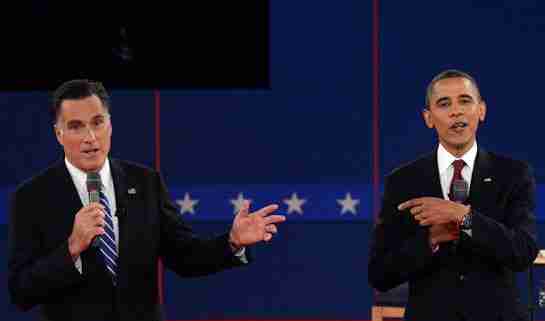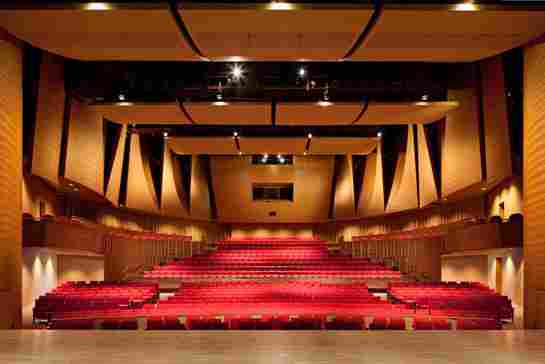In his book Presidential Debates: Fifty Years of High-Risk TV , Alan Schroeder notes that presidential debates happen in two places—theaters and field houses—with the venue influencing the feel. Recall, for example, the 1988 Lloyd Bentsen–Dan Quayle debate (“the rowdiest debate audience in history,” Schroeder notes), which took place in the Omaha Civic Auditorium. Another pressure-filled back and forth, the final between George H.W. Bush and Michael Dukakis, occurred in UCLA’s Pauley Pavilion. The arena, which normally holds 14,000, was reconfigured to house merely 1,500; as one organizer explained at the time: The attendees “realize they’re in a cavernous space, and it does change the mood of the event.”
Today’s debate between President Barack Obama and former Governor Mitt Romney, the last in what has been an extraordinarily charged (and widely seen) series, shifts to the Keith C. and Elaine Johnson Wold Performing Arts Center, at Boca Raton’s Lynn University. Judged merely by the building—sculptural concrete that looks luminous at what photographers call “the magic hour” (the time around sunset when the crowds will arrive); warm, undulating cherry acoustic paneling lining the auditorium itself; starburst chandeliers in the lobby modeled on those at the Metropolitan Opera; the well-heeled Boca crowd itself—one might expect a quiet, civil audience (though there’s no predicting what base-stoking fireworks will play out on stage). Then there’s the university itself. “The setting of the school is really quite wonderful,” says architect Herbert S. Newman, whose New Haven, Connecticut–based firm, Newman Architects , designed the theater, as well as two other campus buildings. “It has all of the wonders of south Florida—the sun, the sea, the green.”

For architecturally minded debate viewers, there are a few things to consider: The centerpiece of the building is the faceted concrete decagon, which, as Newman notes, was built using a “concrete tilt-up system” to economize on cost and energy consumption. The architect explains that “the building was actually formed on the ground in large concrete panels, and they were all tilted up together, like the petals of a flower.” The interior space of the theater, he notes, influenced as you might expect by acoustic and sightline criteria, is “based upon what it would be like to be inside a musical instrument.” The entering audience descends via ramps in the center of the house, so “the choreography of the place is designed to make the attendee feel as if they are a part of the process.” The aisles visitors walk to reach their seats are gently curved—“We did that to give a little air of mystery, a bit like a curving fairway on a golf course, where the green is hidden behind the curve. You’re intrigued to walk down.”

While Newman says his firm is “delighted that the debate will be held in a building we designed,” he is under no illusion as to the amount of exposure it will actually receive in its star turn. “What’s interesting in the debates I’ve seen, not only this year but in any past, is one gets the sense there is almost an anonymity to the site that’s selected in terms of what the viewer sees,” he says. Remember much about the architecture of Hofstra University’s David S. Mack Sports and Exhibition Complex, or the University of Denver’s Magness Arena, the sites of the previous two debates? What we tend to remember is the black box of a proscenium theater, a few podiums, a stage to be strode across, a stool on which to visually rebuke your opponent’s declarations—an anonymous arena for rhetorical combat, framed and flattened by television.
“I wonder if there’s something in the mind of the campaigns,” Newman speculates, “that denies the regionalism of the location because it’s a national audience.” Commenting on the irony, he adds, “The notion of the architecture making a place was an extremely important part of our concept, that when you arrived at the building and were in it, you’d feel a sense of calm and repose. Whether that will or will not be experienced on TV, I have no idea.” Indeed, if there’s one phrase that neither the audience of a debate, nor the participants themselves, likely associates with such an event, it’s calm and repose.
